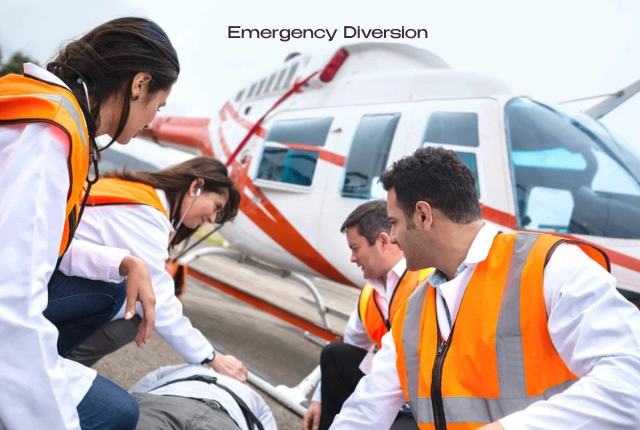Emergency Diversion: What It Means and How to Handle It

Imagine being 35,000 feet in the air when an announcement is made that your flight is being redirected to a different location. This scenario, referred to as an emergency diversion, can throw schedules into chaos, cause anxiety, and leave passengers looking for answers. Knowing what emergency diversion involves, the reasons for it, and the strategies for dealing with it is crucial for minimising the stress that accompanies such scenarios.
In this guide, we will explore the concepts of emergency diversion, its associated cases, real-life scenarios, and steps one can take to remain vigilant and prepared. Regardless of whether you are a frequent flyer or preparing for your first long-haul journey, this guide will provide you with useful information to enable you to travel with confidence.
Table of contents
What Is An Emergency Diversion?
An emergency diversion occurs when an aircraft, for any number of reasons, needs to land at an airport other than the designated one for the flight. This change in the flight path is undertaken for urgent, usually critical medical or mechanical reasons like:
- Health complications
- Technical difficulties
- Safety concerns
- Unforeseen weather patterns
These types of diversions are made in collaboration with the control tower and the pilot of the craft and are made solely for the safety of all passengers.
Most Common Causes for Emergency Diverting
1. Medical Issues
Sometimes a flight may be interrupted due to health-related issues that require immediate medical intervention. A report presented in the New England Journal of Medicine suggests that such medical emergencies occur once in every six hundred flights.
2. Mechanical and Technical Problems
Precautionary diversions are triggered by mechanical issues, engine failures, faulty sensors, or hydraulic issues. Safety regulations stress more adherence to schedule avoidance during these emergencies.
3. Security Issues
Suspicious actions, threats, or fights occurring within the aircraft may lead the aircraft to land at the safest nearby airport to avert further escalation.
4. Extreme Weather
Thunderstorms, sudden turbulence, or poor visibility at the runway can be dangerous for both the aircraft and the people onboard.
5. Operational Problems
Inaccurate calculations of fuel, traffic congestion within the airspace, as well as flight attendants under FAA duty time restrictions contribute to operational issues.
Case Study of Emergency Diverting
- Delta Flight DL275 was diverted to Los Angeles on July 17, 2025 and the flight passengers experienced extreme turbulence. The fatigue caused some crew members to nap resulting in mismanagement and leaving hundreds of passengers stranded overnight.
- British Airways Flight BA274 was diverted to Calgary after smoke was reported in the cabin, which confusingly triggered a malfunctioning air-conditioning unit.
- Lufthansa Flight LH403 was en route from Newark to Frankfurt when the cabin crew detected pressure issues mid-flight and decided to make an emergency landing in Dublin.
- Every one of these incidents underscores various reasons that can elicit diversion and emphasises the need for safety instead of convenience.
How Airlines Handle Emergency Diversions
Communication and Coordination
Airlines manage communication with local aviation facilities, the emergency responders, and the ground personnel regarding passenger disembarkation as well as the landing logistics.
Passenger Support
Airlines may provide the following support as the situation warrants:
- Mealtime and lodging vouchers
- Rebooking services
- Medical attention
- Surface transport
However, location, carrier, and the emergency’s nature dictate the level of assistance offered.
Post-Diversion Procedures
As the issues are settled, airlines figure out if they should:
- Proceed to the original destination
- Cancel the flight and rebook the passengers
- Segregate passengers onto another aircraft
What Passengers Should Do During an Emergency Diversion
1. Stay Calm and Follow Crew Instructions
Listen to announcements. Each crew member is responsible for your safety so they will guide you throughout the entire process so make sure to abide by their instructions.
2. Keep Essentials Accessible
Always keep the following important items in your hand luggage:
- Passport and ID
- Required medications
- Mobile phone with charger
- Snacks and bottled water
- Documents required for travel
3. Stay Informed
Track your flight and its new landing location using airline apps or other trackers like FlightAware or FlightRadar24.
4. Document the Experience
Document times, announcements, and interactions. This information may be useful for reimbursement or insurance claims.
5. Verify Your Rights
Eligibility for compensation depends on the countries of departure and arrival; for instance, travellers within the EU are protected under Regulation 261/2004.
Preventive Tips for Travellers
- Ensure you purchase insurance that includes delays and diversions.
- Make sure to download the airline’s app for real-time updates and boarding passes.
- To allow effective communication with the airline, provide updated contact details.
- Understand your rights based on your country of origin and intended travel route.
If possible, book direct flights to minimise connection issues in the event of a diversion.
Emergency Diversion from the Airline’s Perspective
Substantial amounts are spent by airlines on training, developing structured procedures, and strategic plans for the efficient handling of diversions. By FAA regulations, all flight crews must complete simulator training for emergency procedures. Most airlines also have operational control and crisis teams to provide logistics for the operation and support for the passengers.
Legal and Regulatory Oversight
All necessary safety and emergency protocols for the aircraft are set in strict policies by the FAA and ICAO. These include:
- Mandatory reserve fuel levels
- Protocol for emergency equipment on board
- Standard for medical kit on board
- Regulated pilot duty hours with legal limits
- These frameworks focus on commercial aviation safety.
Infographic: Top 5 Reasons for Emergency Diversion
([Insert a visual with percentages or chart for: Medical (35%), Weather (25%), Mechanical (20%), Security (10%), Others (10%)])
Conclusion
Responding to an emergency always comes with a heavy burden—whether it be an inconvenience or an unwanted interruption. In the context of air travel, such interruptions can be termed a diversion. It is important for travellers to recognise that while such diversions are inconvenient, they serve the critical role of doing everything possible to preserve life and ensure passenger safety. Moreover, understanding the rationale behind diversions and how to respond empowers one with the self-confidence needed to navigate travel seamlessly.
As the airline industry’s commitment to safety, each and every emergency diversion serves as a testament to the precautions undertaken to preserve passenger safety.
Imagine being 35,000 feet in the air when an announcement is made that your flight is being redirected to a different location. This scenario, referred to as an emergency diversion, can throw schedules into chaos, cause anxiety, and leave passengers looking for answers. Knowing what emergency diversion involves, the reasons for it, and the strategies for dealing with it is crucial for minimising the stress that accompanies such scenarios.
In this guide, we will explore the concepts of emergency diversion, its associated cases, real-life scenarios, and steps one can take to remain vigilant and prepared. Regardless of whether you are a frequent flyer or preparing for your first long-haul journey, this guide will provide you with useful information to enable you to travel with confidence.
FAQS
1. What causes an emergency diversion during a flight?
An emergency diversion can be prompted by critical events such as medical emergencies, mechanical malfunctions, security threats, severe weather, or operational challenges. These decisions prioritize passenger safety and are executed in coordination with air traffic control and airline procedures.
2. How do airlines support passengers during an emergency diversion?
Airlines typically coordinate with local ground crews to offer assistance, which may include meal vouchers, accommodation, rebooking, or medical care. The level of support often depends on the airline, location, and the nature of the emergency
3. What should I do if my flight is diverted unexpectedly?
Stay calm, follow crew instructions, and keep essential items—like identification, medication, and chargers—within easy reach. Use airline apps or flight trackers to stay updated, and document all details for possible insurance or compensation claims.





